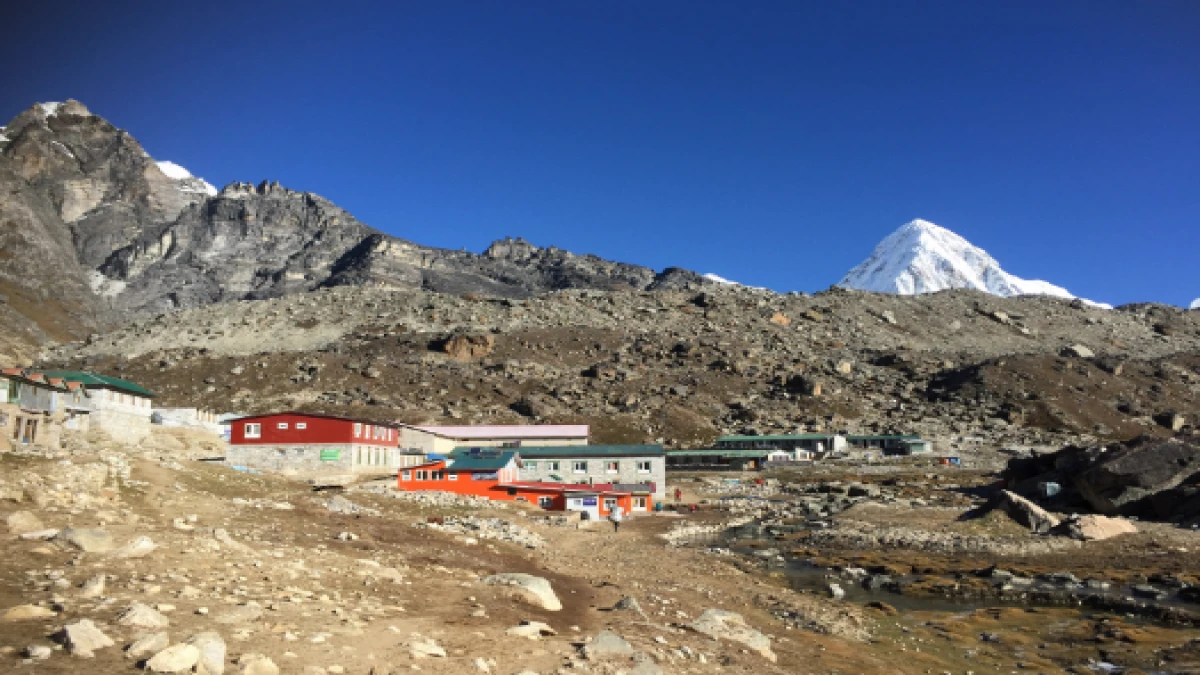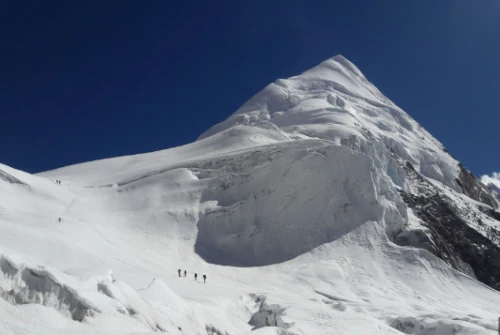What Is the Trek Difficulty and Total Distance?
The Lobuche Peak Climb via Everest Base Camp is a strenuous trek and climb, rated challenging due to both the duration and altitude. Over 16 days, we walk approximately 130–140 kilometers (80–87 miles) from Lukla to Everest Base Camp, to the Lobuche summit and back. The trek includes long walking hours (5–8 hours daily), multiple high passes, glacial moraines, and eventually, the technical climb to the 6,119m summit.
While the Everest Base Camp portion is mostly a non-technical high-altitude hike, the summit day is demanding. It includes pre-dawn starts, icy slopes up to 60° incline, and usage of fixed ropes and crampons. A certified climbing guide leads this part, ensuring safety and support. Many trekkers find the emotional and physical exertion deeply rewarding, especially with the surreal 360° views from the summit.
When Is the Best Time to Do Lobuche Peak Climb?
The best seasons for Lobuche Peak Climbing are spring (March to May) and autumn (late September to early November). These windows offer clear skies, stable weather, and safe climbing conditions on the summit ridge.
Spring (March to May): The Khumbu bursts into color with blooming rhododendrons, and the air is crisp but not freezing. Temperatures at lower altitudes are mild (10–20°C), while high camps and summit nights can drop to -10°C to -20°C. Snow conditions are usually stable, and it’s also the main Everest climbing season, so Base Camp is alive with expedition tents and climber activity, which trekkers love to witness.
Autumn (late September to November): This is considered the clearest season, offering picture-perfect views of Ama Dablam, Everest, and Nuptse. Temperatures are slightly colder than spring, especially at night, but still manageable. Autumn brings golden light, fewer chances of snowfall, and fewer high winds on summit days, making it ideal for both trekking and peak climbing.
Avoid monsoon (June to August) due to slippery trails, high avalanche risks, and flight delays. Winter climbs (December to February) are possible for highly experienced teams but not generally recommended due to extreme cold, snow cover, and fewer open teahouses.
What Is the Accommodation and Food Like on the Trail?
Along the Lobuche route via Everest Base Camp, we stay in traditional Nepali teahouses, cozy, family-run lodges made of stone and wood that offer both shelter and Sherpa warmth. Rooms are basic (twin-sharing), with thick blankets and shared or private bathrooms depending on location. The higher we go, the more rustic it gets. In Lobuche High Camp, accommodation shifts to expedition-style tents, offering an authentic mountaineering vibe beneath a million stars.
Food is hearty, wholesome, and comforting. Most trekkers and especially foreigners—fall in love with dal bhat (lentil soup, rice, vegetable curry, pickles), which is energy-rich and endlessly refillable. Other favorites include Sherpa stew, Tibetan bread, mo: mo (dumplings), fried rice, and even pasta or pizza in places like Namche Bazaar. Teahouses also offer ginger lemon honey tea, a trail favorite for soothing altitude-strained throats.
High camp meals are simpler: boiled eggs, energy bars, soup, noodles, and lots of hot tea. Food and water become more expensive with altitude, as everything is carried up by porters or yaks, but the experience of eating a warm meal surrounded by 6,000-meter peaks? That’s priceless.
What Permits Are Required for Lobuche Peak Climbing?
Climbing Lobuche Peak and trekking to Everest Base Camp requires several permits, which your trekking agency will typically arrange. Here's a breakdown:
Permit Type | Cost (Approx.) | Where It's Needed |
Sagarmatha National Park Permit | NPR 3,000 (≈ $25) | For entering the Everest region |
Khumbu Pasang Lhamu Rural Municipality Permit | NPR 2,000 (≈ $15) | Local entry fee for the Khumbu region |
Lobuche Peak Climbing Permit | USD 250 (Spring), USD 125 (Autumn), USD 70 (Winter/Summer) | Issued by Nepal Mountaineering Association (NMA) |
Note: No TIMS Card is required for Everest region treks anymore. Instead, the local Khumbu permit replaces it.
Your guide will carry and present these permits at various checkpoints along the trail.
Technical Difficulty of Lobuche Peak
Although Lobuche Peak is categorized as a trekking peak by the Nepal Mountaineering Association, don’t let the term mislead you—it still involves sections of technical alpine climbing, particularly near the summit. While the lower sections of the climb involve trekking over moraines and snowy ridgelines, the final push to the summit requires the use of crampons, fixed ropes, harnesses, helmets, and ice axes. The summit ridge is narrow and often icy, with a steep 45-50° snow slope that demands good footwork and rope handling skills.
This peak is considered ideal for those who have some basic mountaineering knowledge or are looking to transition from high-altitude trekking to more technical climbs. With proper guidance and acclimatization, many fit and determined trekkers can safely reach the summit under the supervision of experienced climbing Sherpas and guides.
Acclimatization: Gradual Ascent is Key
Proper acclimatization is the foundation of a successful Lobuche Peak climb. The 16-day itinerary is carefully crafted to allow the body to adapt to high altitude, gradually increasing elevation while incorporating rest days in key locations like Namche Bazaar and Dingboche. These pauses help the body adjust to lower oxygen levels, reducing the risk of Acute Mountain Sickness (AMS) and other altitude-related complications.
Additionally, the trek includes visits to Everest Base Camp and Kala Patthar, which not only enhance acclimatization but also elevate the overall trekking experience. Spending time above 5,000 meters before attempting the summit gives climbers a much greater chance of success, as the body becomes better prepared to cope with the demands of the final ascent.
Breathtaking Himalayan Views from the Summit
One of the most rewarding aspects of climbing Lobuche Peak is the spectacular panoramic view that unfolds from its summit. On a clear morning, climbers are treated to a jaw-dropping vista of some of the world’s most iconic Himalayan giants. Directly in front lies Mount Everest, the roof of the world, with Lhotse and Nuptse towering alongside. To the east, the gracefully shaped Ama Dablam rises dramatically, while Makalu, Pumori, Baruntse, and many other peaks complete the awe-inspiring skyline.
The sense of achievement that comes from standing at over 6,000 meters, surrounded by this alpine cathedral of ice and rock, is indescribable. Whether you're an experienced mountaineer or a passionate adventurer seeking a once-in-a-lifetime view, the summit of Lobuche Peak offers a moment of pure Himalayan magic.
Cost of Climbing Lobuche Peak
The cost of Lobuche Peak Climbing via Everest Base Camp can vary depending on the season, group size, and the services included. On average, a 16-day all-inclusive package ranges between USD 2,200 to USD 3,500 per person. This generally includes domestic flights (Kathmandu–Lukla–Kathmandu), accommodation in teahouses and tents, meals, climbing permits, a licensed climbing guide, porters, equipment, and logistics.
The climbing permit fee for Lobuche East alone ranges from USD 70 to 250 depending on the season. Additional costs may include travel insurance with helicopter evacuation, tips for guides and porters, personal climbing gear rental (if needed), and optional sightseeing in Kathmandu. It's advisable to go with a reputable company that provides professional guidance, reliable gear, and comprehensive safety support, rather than simply chasing the lowest price.
Training and Preparation for the Climb
Training for Lobuche Peak Climbing is essential to ensure both physical readiness and mental resilience. While the climb is achievable for beginners with basic mountaineering skills, it is still a demanding high-altitude ascent that requires strong cardiovascular endurance, leg strength, balance, and stamina. Engaging in activities like hiking with a backpack, jogging, stair climbing, cycling, and gym workouts several months before the trip is highly recommended.
In addition to fitness, it's equally important to prepare mentally for the harsh conditions, long trekking days, and altitude challenges. Practicing multi-day treks at home and learning how to use gear like crampons and ice axe will give you greater confidence. Those with prior experience above 4,000–5,000 meters will adapt more quickly, but even first-timers can reach the summit with discipline, proper guidance, and training.
What to Pack for Lobuche Peak Climbing? (Detailed Packing List)
Packing for Lobuche Peak requires balancing warmth, weight, and utility. The journey includes diverse terrain—lush forests, rocky valleys, icy glaciers, and a high-altitude summit—so being properly equipped can make or break your experience.
Clothing Layers
Layering is the golden rule. Here's what you'll need:
- Base Layers (2–3 pairs): Moisture-wicking thermal tops and bottoms (preferably merino wool or synthetic).
- Mid Layers (2 pairs): Fleece jackets or lightweight down pullovers for insulation.
- Outer Layer (1 good quality): Waterproof and windproof shell jacket and trousers (Gore-Tex recommended).
- Down Jacket (Heavy-duty): Must handle temperatures as low as -20°C, especially at High Camp and on summit night.
- Trekking Pants and Shorts: Convertible pants are great.
- Gloves: Inner liner gloves, fleece gloves, and waterproof insulated climbing gloves.
- Headwear: Warm beanie, sun hat, neck buff, and a balaclava or face mask for summit day.
- Climbing Gear (usually provided by your outfitter, but confirm):
- Crampons
- Ice axe
- Climbing harness
- Helmet
- Carabiners and jumar
- Ascender/descender device
- Mountaineering boots (double boots like La Sportiva G2 or Scarpa Phantom 6000 recommended)
Footwear
- Trekking Boots: Waterproof, broken-in, ankle-support boots.
- High-altitude Mountaineering Boots: Insulated double boots for summit.
- Camp Shoes: Lightweight sandals or Crocs to relax in teahouses.
- Gaiters: For snow and debris protection.
Sleep System
- Sleeping Bag: Rated to at least -20°C (can be rented in Kathmandu or Lukla).
- Sleeping Bag Liner: For extra warmth and hygiene.
- Thermal mat: For High Camp sleeping comfort (usually provided).
Personal Items & Hygiene
- Sunscreen (SPF 50+)
- Lip balm with UV protection
- Baby wipes and a small towel
- Toothbrush, toothpaste, deodorant
- Nail cutter, small mirror
- Toilet paper and biodegradable soap
- Hand sanitizer
Essential Gear
- Trekking poles (collapsible)
- Headlamp with extra batteries
- Water bottles (2 liters total capacity)
- Water purification tablets or SteriPen
- Sunglasses with 100% UV protection (category 4 for summit day)
- Power bank or solar charger
- Lightweight duffel bag (carried by porter)
- Daypack (30–40L) for personal items
- First aid kit with altitude meds (Diamox), antibiotics, band-aids, blister care, and prescribed medication
Optional but Useful
- Energy bars, dry fruits, ORS
- Lightweight book or journal
- Camera/GoPro with spare batteries
- Pocket knife or multi-tool
- Trek map or guidebook


 based on 1 review
based on 1 review
